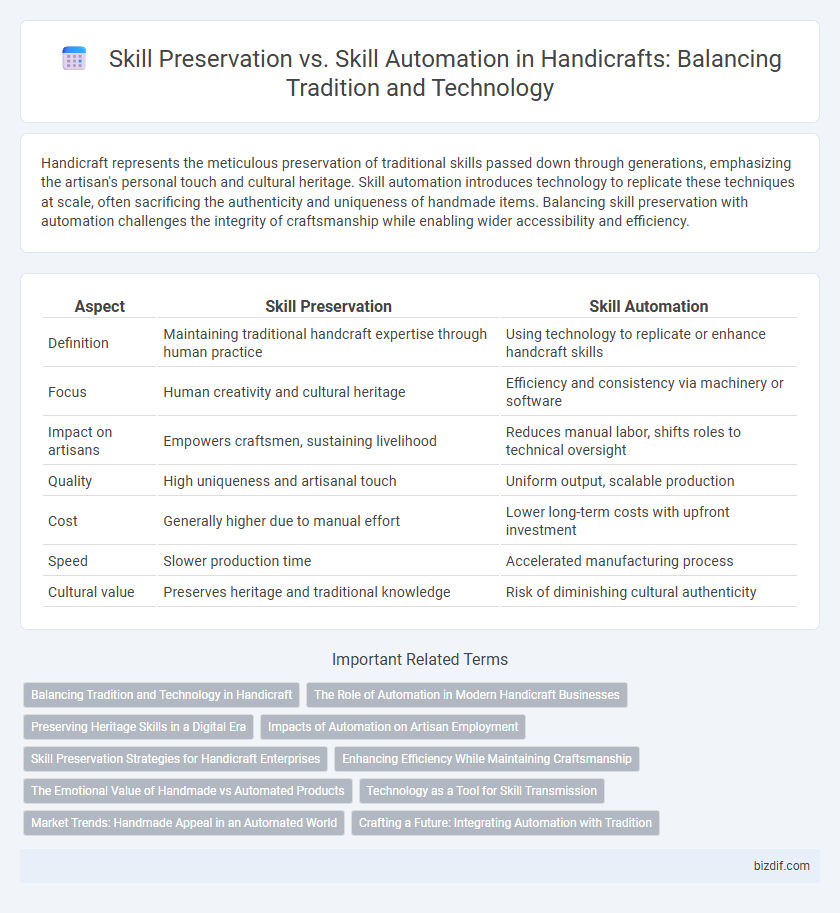Handicraft represents the meticulous preservation of traditional skills passed down through generations, emphasizing the artisan's personal touch and cultural heritage. Skill automation introduces technology to replicate these techniques at scale, often sacrificing the authenticity and uniqueness of handmade items. Balancing skill preservation with automation challenges the integrity of craftsmanship while enabling wider accessibility and efficiency.
Table of Comparison
| Aspect | Skill Preservation | Skill Automation |
|---|---|---|
| Definition | Maintaining traditional handcraft expertise through human practice | Using technology to replicate or enhance handcraft skills |
| Focus | Human creativity and cultural heritage | Efficiency and consistency via machinery or software |
| Impact on artisans | Empowers craftsmen, sustaining livelihood | Reduces manual labor, shifts roles to technical oversight |
| Quality | High uniqueness and artisanal touch | Uniform output, scalable production |
| Cost | Generally higher due to manual effort | Lower long-term costs with upfront investment |
| Speed | Slower production time | Accelerated manufacturing process |
| Cultural value | Preserves heritage and traditional knowledge | Risk of diminishing cultural authenticity |
Balancing Tradition and Technology in Handicraft
Preserving traditional handicraft skills demands meticulous attention to techniques passed down through generations, ensuring cultural heritage remains intact while fostering artisanal identity. Skill automation introduces advanced tools and machinery to enhance efficiency and scalability, yet must complement rather than overshadow the handcrafted essence. Balancing tradition and technology requires integrating digital innovations with manual expertise to sustain craftsmanship quality and promote creative evolution.
The Role of Automation in Modern Handicraft Businesses
Automation enhances efficiency in modern handicraft businesses by streamlining repetitive tasks such as cutting, shaping, and packaging, allowing artisans to focus on intricate design and craftsmanship. Advanced technologies like CNC machines and 3D printers preserve traditional skills by enabling precise replication while reducing material waste and production time. Balancing automation with skilled manual work ensures the preservation of cultural heritage while meeting contemporary market demands.
Preserving Heritage Skills in a Digital Era
Preserving heritage skills in the digital era requires balancing traditional handicraft techniques with innovative technology to maintain cultural authenticity and craftsmanship quality. Digital tools can document intricate methods and provide virtual training platforms, ensuring the transmission of skills across generations without losing historical value. Emphasizing skill preservation over automation safeguards the unique artistry embedded in heritage crafts, fostering cultural identity while embracing technological advancements.
Impacts of Automation on Artisan Employment
Automation in handicrafts significantly alters artisan employment by reducing the demand for manual skills traditionally passed through generations. Mechanized production enhances efficiency and output but often marginalizes skilled artisans, leading to job displacement and loss of cultural heritage trades. Balancing skill preservation with automation requires integrating technology that complements artisan techniques rather than replaces them, fostering sustainable employment in the handicraft sector.
Skill Preservation Strategies for Handicraft Enterprises
Handicraft enterprises implement skill preservation strategies by documenting traditional techniques, conducting master-apprentice training programs, and promoting community workshops to ensure the transmission of artisanal knowledge. Integrating digital archiving and interactive media facilitates the retention of intricate craftsmanship details, fostering cultural heritage continuity. These strategies help maintain the authenticity and uniqueness of handicraft products while enhancing artisans' expertise across generations.
Enhancing Efficiency While Maintaining Craftsmanship
Balancing skill preservation with automation in handicraft involves integrating advanced tools that enhance efficiency without compromising traditional craftsmanship. Automation can handle repetitive tasks, allowing artisans to focus on intricate details and creative expression, thus maintaining the authenticity of handmade products. Leveraging technology strategically ensures higher productivity while safeguarding the unique skills and cultural heritage embedded in each handcrafted piece.
The Emotional Value of Handmade vs Automated Products
Handmade handicrafts embody unique emotional value through the personal touch and cultural heritage infused by skilled artisans, creating irreplaceable connections between creator and consumer. Automated products lack this emotional depth, often perceived as impersonal and standardized despite efficiency and uniformity in production. Preserving traditional craftsmanship ensures the continuation of authentic expressions and emotional resonance that machines cannot replicate.
Technology as a Tool for Skill Transmission
Technology enhances skill preservation in handicrafts by providing digital platforms for detailed tutorials, virtual apprenticeships, and interactive workshops that replicate traditional techniques. Automated tools can replicate repetitive tasks, allowing artisans to focus on creative aspects while preserving intricate manual skills through augmented reality and 3D modeling. This integration fosters sustainable skill transmission by combining traditional craftsmanship with modern technological aids, ensuring the longevity and evolution of artisan knowledge.
Market Trends: Handmade Appeal in an Automated World
The market for handicrafts continues to grow as consumers increasingly value the unique appeal of handmade products over mass-produced, automated goods. Skill preservation in traditional crafts fosters cultural heritage and distinctive artistry that automation cannot replicate, driving demand in niche markets and luxury segments. Despite technological advances, the tangible quality and personalized story behind handmade items remain crucial factors influencing purchasing decisions in a digitally saturated world.
Crafting a Future: Integrating Automation with Tradition
Balancing skill preservation with automation in handicrafts requires integrating advanced tools while maintaining artisanal techniques. Automated processes enhance efficiency and consistency without eroding the unique creativity embedded in traditional craftsmanship. Embracing technology alongside heritage practices ensures sustainable growth and the continuation of cultural legacies in the handicraft industry.
Skill Preservation vs Skill Automation Infographic

 bizdif.com
bizdif.com